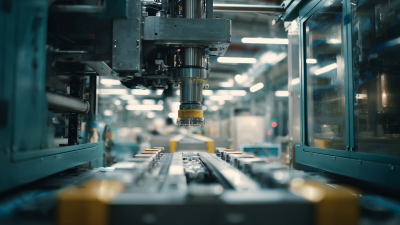As industries continue to evolve with innovative manufacturing solutions, thermoplastic molding stands out as a transformative process that significantly enhances efficiency and product quality. According to Dr. Emily Chen, a leading expert in the field of thermoplastic applications, "The versatility and sustainability of thermoplastic molding are paving the way for a new era of manufacturing." This process allows for rapid prototyping, intricate designs, and a reduced carbon footprint, making it an ideal choice for companies looking to stay competitive in the fast-paced market.

The advantages of thermoplastic molding are not only numerous but also essential for modern production demands. From increased production speed to the flexibility of reusing raw materials, manufacturers are recognizing the value of adopting this approach. As we delve into the top five benefits of thermoplastic molding, it becomes clear that the integration of this technology is more than just a trend; it's a fundamental shift that supports innovation and sustainability in manufacturing. The forthcoming discussion will unveil these advantages, showcasing how thermoplastic molding can redefine manufacturing solutions for the future.
Thermoplastic molding has transformed the way manufacturers approach production cycles, primarily due to its remarkable speed and efficiency. Unlike traditional methods, thermoplastic materials can be melted and reshaped multiple times, which drastically reduces the time needed for setup and production changes. This flexibility allows manufacturers to respond quickly to market demands, enabling faster iterations of product designs and quicker launch times for new innovations.
Moreover, the rapid cooling process of thermoplastics solidifies products swiftly, minimizing delays associated with curing or hardening phases found in other materials. This quick turnaround not only enhances overall productivity but also results in decreased manufacturing costs. As businesses strive for agility in the evolving landscape of consumer preferences, the ability to accelerate production cycles through thermoplastic molding provides a significant competitive edge, allowing them to bring innovative solutions to market faster than ever before.
| Advantage | Description | Impact on Production | Examples of Applications |
|---|---|---|---|
| Rapid Production | Thermoplastic molding allows for quick cycle times, facilitating faster production. | Increased output and reduced lead times in manufacturing. | Consumer products, automotive parts, and electronics. |
| Cost Efficiency | Lower material and production costs compared to traditional molding methods. | Enhanced profit margins and reduced waste. | Packaging, toys, and industrial components. |
| Design Flexibility | Easier to alter designs mid-production, accommodating changing customer needs. | Reduction in time and cost associated with design changes. | Consumer electronics and customized products. |
| Recyclability | Thermoplastics can be reprocessed, contributing to sustainable manufacturing efforts. | Reduced environmental impact and compliance with regulations. | Eco-friendly products, automotive interiors. |
| Enhanced Strength | Advanced thermoplastic composites provide higher durability and strength. | Longer product lifespans and decreased failure rates. | Automotive parts, aerospace components, and medical devices. |
Thermoplastic molding offers unparalleled versatility in design, enabling manufacturers to create highly customized products that meet specific consumer needs. The adaptability of thermoplastic materials allows for intricate shapes and detailed features that are often difficult to achieve with traditional manufacturing methods. This flexibility is not only beneficial for creating unique product designs but also allows manufacturers to experiment with various textures, finishes, and colors. As a result, businesses can differentiate their products in a crowded marketplace, appealing to a broader range of customers.
Moreover, the use of thermoplastic materials facilitates rapid prototyping, which is crucial in today's fast-paced manufacturing environment. Designers can quickly iterate on product concepts, making adjustments based on feedback without incurring prohibitive costs or time delays. This agility in the design process fosters innovation and encourages the development of sustainable products, as thermoplastics can be recycled and reused. By embracing thermoplastic molding, manufacturers are empowered to push the boundaries of creativity while maintaining efficient production workflows, ultimately leading to more innovative and tailored solutions for their customers.
Thermoplastic molding has emerged as a formidable technique in innovative manufacturing, particularly due to its cost-effectiveness. According to a recent report by MarketsandMarkets, the global thermoplastic polymer market is expected to grow from $48.6 billion in 2022 to $76.4 billion by 2027, reflecting an increasing shift towards thermoplastic applications across various industries. This growth is partially fueled by the ability of thermoplastic molding to reduce production costs while maintaining high-quality outputs. By streamlining the manufacturing process, companies can significantly minimize labor costs and reduce material waste—up to 30% less waste compared to traditional methods.
Moreover, thermoplastic molding supports rapid prototyping and short production runs, enabling businesses to respond quickly to market demands without incurring excessive expenses. A study by Allied Market Research indicated that businesses utilizing thermoplastic molding techniques can achieve a reduction in lead times by as much as 50%. This increase in efficiency not only enhances productivity but also allows manufacturers to reallocate resources toward innovation and development. The adaptability and cost-saving benefits of thermoplastic molding underscore its role as a cornerstone for companies seeking to thrive in today's competitive landscape.
This bar chart illustrates the top five advantages of thermoplastic molding in innovative manufacturing solutions. The ratings represent the perceived value of each advantage on a scale of 1 to 10, showcasing the effectiveness of thermoplastic molding techniques in maximizing efficiency and offering cost-effectiveness, design flexibility, speed of production, material versatility, and reduced waste.
Thermoplastic molding stands out as a pivotal innovation in manufacturing, especially when it comes to its eco-friendly advantages.

One of the most significant benefits of thermoplastic materials is their recyclability. Unlike traditional thermosetting plastics that cannot be remolded once cured, thermoplastics can be melted down and reshaped multiple times without losing structural integrity. This process not only minimizes waste but also conserves energy and raw materials, paving the way for a more sustainable approach to manufacturing.
In addition to being recyclable, thermoplastic molding offers reduced emissions during production. The manufacturing process typically requires lower temperatures compared to other plastic production methods, leading to a decrease in energy consumption and harmful emissions.
As industries grapple with the pressing need to address environmental impacts, the adoption of thermoplastic molding represents a meaningful step towards sustainable practices. By integrating eco-friendly materials and processes, manufacturers can create innovative solutions that align with the growing demand for responsible production in today’s market.
Thermoplastic molding is increasingly recognized for its enhanced durability, providing significant strength and resilience in various manufacturing applications. According to a report by Smithers Pira, the global market for thermoplastic materials will reach $300 billion by 2025, indicating a robust demand for components that can withstand rigorous conditions. These materials, unlike thermosets, retain their strength and flexibility across a wide range of temperatures and stress conditions, making them ideal for products requiring long-term performance.

Additionally, the durability of thermoplastic components is significantly influenced by their molecular structure, allowing manufacturers to engineer materials with enhanced impact resistance and tensile strength. A study conducted by the American Society of Mechanical Engineers (ASME) noted that thermoplastic materials exhibit up to 30% greater impact strength compared to traditional alternatives, reducing the likelihood of product failure in demanding environments. This advantage not only prolongs the lifespan of components but also can ultimately lead to cost savings for manufacturers through decreased replacement and repair cycles.






